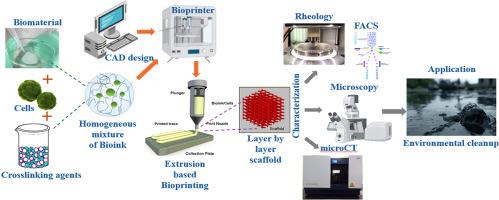Three-dimensional bioprinted materials in alginate-hyaluronic acid complex based hydrogel based bio-ink as absorbents for heavy metal ions removal
IF 6.2
Q1 CHEMISTRY, APPLIED
Carbohydrate Polymer Technologies and Applications
Pub Date : 2024-10-15
DOI:10.1016/j.carpta.2024.100588
引用次数: 0
Abstract
Major environmental and health effects arise from the presence of heavy metals in water, including lead (Pb²⁺), mercury (Hg²⁺), chromium (Cr⁶⁺), cadmium (Cd²⁺), and arsenic (As³⁺), which contribute significantly to water pollution and pose severe risks to ecosystems and human health. This study demonstrates the fabrication of 3D printed self-regenerative functional living materials, a fungi, by using mixture of sodium alginate and hyaluronic acid hydrogel as absorbents to remove the heavy metals from the environment. Bioprinting has emerged as a transformative technology for fabricating complex biological constructs. The bioprinting experiments, conducted with optimized parameters, revealed the viscoelastic behavior of the hydrogel, suitable for 3D bioprinting applications. MicroCT analysis indicated that the hydrogel's porosity and structural properties support fungal growth in a controlled three-dimensional setting. Microscopic analyses, including phase contrast microscopy, FESEM, and HRTEM, provided insights into the cellular morphology of the bioprinted constructs. Cell viability was assessed using flow cytometry with FDA and PI staining, showing a significant population of live cells, affirming the biocompatibility of the hydrogel. Additionally, the study explored the hydrogel's potential for heavy metal removal from water samples. Multi-element standard solutions containing Copper (Cu²⁺), Cadmium (Cd²⁺), Nickel (Ni²⁺), Cobalt (Co²⁺), and Ferrous (Fe³⁺) ions at different concentrations were incubated with hydrogel patches embedded with Aspergillus flavus. Atomic absorption spectrophotometry analysis showed rapid initial removal rates of metal ions, with maximum removal efficiency achieved around the 12th hour. Comparisons with a control hydrogel without the fungal strain demonstrated significantly enhanced removal efficiency due to the presence of Aspergillus flavus. This study highlights the dual functionality of sodium alginate with hyaluronic acid -based hydrogels for bioprinting fungi and for environmental remediation of heavy metals, offering promising applications in environmental cleanup.

海藻酸-透明质酸复合水凝胶生物墨水中的三维生物打印材料作为重金属离子去除吸收剂
水中重金属(包括铅(Pb²⁺)、汞(Hg²⁺)、铬(Cr⁶⁺)、镉(Cd²⁺)和砷(As³⁺))对环境和健康产生重大影响,严重加剧了水污染,对生态系统和人类健康构成严重威胁。本研究展示了利用海藻酸钠和透明质酸水凝胶的混合物作为吸附剂,制造三维打印的自再生功能性活体材料--真菌,以去除环境中的重金属。生物打印已成为制造复杂生物构造物的变革性技术。采用优化参数进行的生物打印实验揭示了水凝胶的粘弹性行为,适合三维生物打印应用。显微 CT 分析表明,水凝胶的孔隙率和结构特性支持真菌在受控三维环境中生长。相衬显微镜、FESEM 和 HRTEM 等显微分析有助于深入了解生物打印构建体的细胞形态。使用 FDA 和 PI 染色流式细胞仪对细胞存活率进行了评估,结果显示有大量的活细胞,这肯定了水凝胶的生物相容性。此外,研究还探讨了水凝胶去除水样中重金属的潜力。将含有不同浓度的铜(Cu²⁺)、镉(Cd²⁺)、镍(Ni²⁺)、钴(Co²⁺)和亚铁(Fe³⁺)离子的多元素标准溶液与嵌入黄曲霉的水凝胶贴片一起培养。原子吸收分光光度法分析表明,金属离子的初始去除率很快,在第 12 小时左右达到最高去除效率。与不含真菌菌株的对照水凝胶相比,由于黄曲霉的存在,去除效率明显提高。这项研究强调了海藻酸钠与透明质酸水凝胶的双重功能,既可用于真菌的生物打印,也可用于重金属的环境修复,在环境净化方面具有广阔的应用前景。
本文章由计算机程序翻译,如有差异,请以英文原文为准。
求助全文
约1分钟内获得全文
求助全文

 求助内容:
求助内容: 应助结果提醒方式:
应助结果提醒方式:


